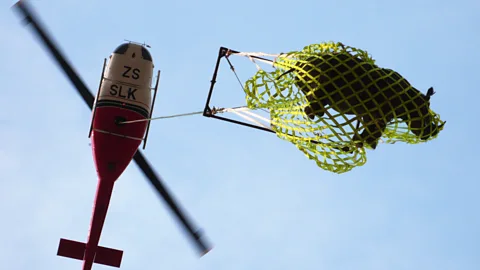In Rusch’s experience, researchers and conservationists employ two main helicopters to transport black rhinos: the Airbus AS350 Astar and the UH1-H Huey.
The Airbus AS350 Astar, nicknamed the “Squirrel,” has been used since 2021, says Rusch. This helicopter is small, cost-effective and readily available in South Africa, she adds.
UH1-H Hueys, on the other hand, are designed for lifting large loads. Famously used during the Vietnam War, some of these “iconic helicopters” still exhibit bullet hole patches and floor installations for mounted gun covers, says Rusch. Nowadays, these military-grade helicopters – complete with windows under the cockpit so the pilot can see the ground below – are valuable for civilians in firefighting and rhino conservation.
“The Hueys’ blades have a unique flap – they really slap the air,” Rusch says. “That was the sound soldiers in the Vietnam war wanted to hear, feeling that relief of someone rescuing them.” The Huey – made famous by Hollywood films including Apocalypse Now, Platoon and Full Metal Jacket – has become synonymous with the Vietnam War and provided close heliborne support to US soldiers, evacuating the wounded and the dead.
Carbon Count
The emissions from travel it took to report this story were 0kg CO2. The digital emissions from this story are an estimated 1.2g to 3.6g CO2 per page view. Find out more about how we calculated this figure here.
The fateful twist of using a machine of war to save lives is not lost on the conservationists who fly in the helicopters. “Ironically, in the 80s, helicopters were used by some poachers to kill rhinos,” says Radcliffe. “The fact that helicopters are now being used to save them is a wonderful example of conservation.” Translocation is one of the most valuable tools of rhino conservation, he adds.
WWF’s Black Rhino Range Expansion Project has 18 project sites, with over 400 black rhinos spread across the site, making up 15% of all black rhinos in South Africa, says Rusch. “Really none of this would be possible without helicopters, both in terms of darting and transferring rhinos out of inaccessible areas,” she says.
Radcliffe’s team, which partnered with Namibia’s government, pioneered the netless, slinging method of moving rhinos upside down under a helicopter. In 2021, Radcliffe and his colleagues won an Ig Nobel Prize – an award satirising the Nobel Prize given to “research that makes people laugh and then think” – for their work on hanging black rhino upside down.
 BRREP WWF
BRREP WWFAs the opioid used reduces the rhinos’ blood oxygen levels, it’s all the more crucial to determine which flight position is best for breathing. Before settling on the upside-down position, Radcliffe and his fellow researchers tried laying the flying rhinos on boards tethered to the helicopter, which wasn’t aerodynamic as the board caused excess swaying in mid-air, says Radcliffe.
Then, his team tested rhinos in nets, which “aerodynamically worked a bit better, but still wasn’t ideal“. The net’s positioning compromised the rhino’s breathing. Plus, the net’s metal frame added considerable weight and required even more ground personnel to place the rhinos into the net, “which defeated the purpose of having a quick and efficient transport method”, explained Radcliffe.
Airborne inversion is the safest option, says Radcliffe. The anatomy of the rhino means it is, remarkably, able to breathe comfortably upside down, Radcliffe says. Hanging by their legs, the weight and build of rhinos allow them to extend their head and neck downwards, straightening the spine. Also, a “safer, smoother flight” occurs because the rhino horn acts as a “tail feather or wind vane,” reducing the risk of spinning. “The great thing about lifting the rhinos upside down by their feet is that they’re aerodynamic themselves,” says Radcliffe.
While the image of an upside-down rhino may initially seem “cruel”, the rhino’s well-being is always “paramount” before, during and after the 10-30 minutes of airborne time, says Rusch. “The rhino is constantly under supervision of experienced veterinarians and pilots, who can tell if the rhino is comfortable or straining,” she says.